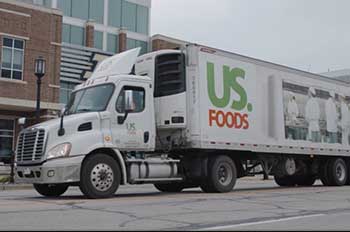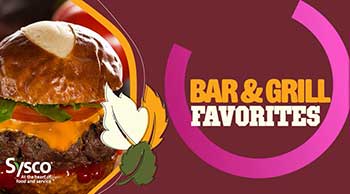The foodservice distribution industry in the United States is dominated by two major players – US Foods and Sysco. Both companies deliver food and non-food products to restaurants, healthcare and hospitality businesses across the country.
But when it comes to choosing between the two for your business, which one comes out on top? This comprehensive guide examines the key differences between US Foods and Sysco to help you determine the better option.
A Brief Comparison Table
| Category | US Foods | Sysco |
| Company Size | $29 billion annual revenue | $68 billion annual revenue |
| Distribution Reach | 60+ distribution centers concentrated in Central, Midwest, Eastern and Southern US | 80+ distribution centers across US and Canada |
| Product Selection | 350,000+ SKUs. Good selection but fewer specialty items. | 400,000+ SKUs including 39,000 local products. Broader specialty selection. |
| Ordering Technology | Robust online platform US Foods Connect. Seamlessly integrates with POS systems. | Online ordering platform less user-friendly than US Foods. Lags in digital capabilities. |
| Pricing Approach | Customized pricing negotiated directly with each customer. | Tiered pricing model based on volume. Highest volume = lowest per case cost. |
| Customer Service | Proactive support model focused on satisfying customers. | Dedicated account reps provide personalized service. Some inconsistencies reported. |
| Contract Terms | Customized contract length and terms. | Standard 1-5 year contracts. |
| Additional Offerings | Financial solutions, loan assistance, customized shipping. | Marketing services, menu insights, sustainability consulting. |
Company Overview
US Foods and Sysco have remarkably similar histories. Both companies were founded in the late 1960s and grew rapidly through acquisitions of smaller broadline distributors. Today, they remain the two largest foodservice distributors in the country.

US Foods was founded in 1989 and is headquartered in Rosemont, Illinois. They distribute over 350,000 products to over 250,000 restaurants and foodservice operators across the United States. US Foods went public in 2016 after being privately held by investment firms for many years.
Sysco has its headquarters in Houston, Texas and was founded in 1969. Sysco distributes products to over 600,000 customer locations throughout the US and internationally. They are publicly traded and currently the larger of the two companies in terms of revenue.
Both companies offer broadly similar products and services including dry goods, frozen foods, produce, meat and seafood, janitorial supplies, disposables and restaurant equipment. They also provide value-added services like menu analysis, food safety training and on-site kitchen design.
Us Foods And Sysco: Key Features Compared
- Geographic Coverage
One of the first considerations when choosing a foodservice distributor is their geographic coverage.

Sysco has over 80 distribution facilities located across the US and Canada. This gives them a slightly larger distribution footprint than US Foods, with the ability to deliver nationwide.
US Foods has 60+ distribution centers concentrated mostly across the Central, Midwest, Eastern and Southern regions. They may have fewer facilities compared to Sysco but can still deliver coast-to-coast.
For businesses with a national presence, either distributor should be able to meet their delivery needs. The coverage differences come into play more for regional restaurant chains located outside US Foods’ core areas.
- Product Selection
Both companies offer extensive product catalogs with hundreds of thousands of SKUs covering all food and non-food categories.
Sysco prides itself on product selection and innovation. They carry over 400,000 products including 39,000 local and regional items tailored to each market. Sysco has a strong focus on developing solutions to meet evolving consumer preferences around freshness, nutrition, sustainability and more.
US Foods boasts 350,000 SKUs across both national brands and local favorites. They also provide access to 45,000 additional items through their e-commerce platform. While their selection doesn’t have quite the depth and specialty focus of Sysco’s, it covers all the core products restaurants need.
For most operators, the product range of both companies will satisfy purchasing needs. But for those requiring unique, hard-to-find items, Sysco may have a leg up.
- Ordering and Technology
When it comes to ordering technology and overall digital capabilities, US Foods edges out Sysco.
US Foods offers a robust online ordering platform called US Foods Connect that syncs seamlessly with some of the industry’s leading POS systems. Customers can browse products, track order status, manage invoices and access reporting digitally 24/7.
They also utilize AI and predictive analytics to improve demand forecasting and inventory management. Handheld technology used by reps improves communication between customers, salespeople and drivers.
Sysco lags slightly behind in this area. While they do have an online ordering platform, some users report it being more difficult to navigate than US Foods’ platform. Sysco does seem to be actively enhancing their digital capabilities but still has some catching up to do.
For businesses looking to maximize technology and automation, US Foods is the leader in this space currently.
Also Read: Comparison Between Sygma And Sysco.
- Pricing and Contract Terms
Food distribution is a high volume, low margin industry. That puts cost and negotiated contract terms front and center when restaurants evaluate distributors.
Sysco uses a tiered pricing model based on purchasing volume. The highest volume customers get the lowest cost per case, while smaller volume accounts pay more.
They typically negotiate contracts for 1-5 years. Shorter term contracts allow for more frequent renegotiation but less price protection. Multi-year deals offer pricing stability but less flexibility.
US Foods takes a company-wide custom pricing approach. They work with each customer to determine optimal pricing based on purchasing analytics Vs. preset tiers. Contracts are also customized around length, terms and pricing schedules.
This strategy allows US Foods to tailor costs more precisely to each operator’s needs. However, Sysco’s tiered model provides simpler upfront price transparency.
Smart negotiating can yield competitive pricing from either distributor. US Foods may offer greater advantages for high volume national accounts. On the other hand, operators with fewer locations may prefer Sysco’s transparent pricing tiers.
- Customer Service
In an industry with slim profit margins, customer service and support can be differentiating factors.
Sysco assigns dedicated account reps to each customer for personalized service. They also have a strong focus on menu analysis and marketing support to help operators optimize offerings.
However, some customers indicate inconsistent order accuracy and timeliness as weaknesses in Sysco’s customer service. Missed items and delivery delays happen too frequently according to some reports.
US Foods promotes their “white glove service” approach. They aim to address customer needs proactively versus reactively. Their customer satisfaction rates are high, thanks in part to their investment in technology to improve operations.
Third-party data shows US Foods edging out Sysco in customer service scores. But large distributors struggle with service gaps at times given the vast scale of their operations.
- Additional Offerings
Aside from core distribution services, US Foods and Sysco both provide a range of programs and partnerships.
Sysco offers marketing services, menu insights, food safety training, and sustainability consulting. Their Culinary Labs develop recipes and provide product innovation guidance.
US Foods provides similar offerings like kitchen design, nutrition analysis, and culinary services. Unique offerings include cash flow solutions, loan assistance, and customized shipping solutions.
Opportunities exist with both companies to leverage data, culinary expertise, and operational support beyond just distribution. US Foods may cater better to the full financial needs of restaurant operators.
Also Read: Comparison Between PFG And Sysco.
Frequently Asked Questions (FAQ)
Sysco is currently the larger company in terms of both revenue and geographic scope. In its fiscal year 2022, Sysco reported $68 billion in sales compared to US Foods’ $29 billion. Sysco also has a larger distribution footprint with 80+ facilities versus 60+ for US Foods.
Sysco and US Foods are often viewed as very similar since they are the two largest broadline foodservice distributors in the US. However, there are some key differences between the two companies:
Sysco has a more international presence compared to US Foods which operates only domestically.
US Foods has more advanced ordering technology and digital capabilities.
Sysco provides marginally broader product selection and specialty items.
Sysco follows a tiered pricing model while US Foods offers custom pricing.
So while the two companies compete directly, they have unique strengths, coverage footprints and strategic focus.
Sysco attempted to acquire US Foods in 2013 but the merger deal was blocked by the FTC over antitrust concerns. This prevented Sysco from taking over US Foods and monopolizing the foodservice distribution industry. The two companies continue to operate as independent competitors to this day.
The primary competitors to Sysco are:
US Foods – The other large broadline distributor with national scale and similar offerings.
Performance Food Group (PFG) – The 3rd largest foodservice distributor focused mainly on the eastern US.
Gordon Food Service (GFS) – Focuses largely on the Midwest region.
Reinhart Foodservice – Operates 140+ locations across the US.
Shamrock Foods – Specializes in the western US market.
Additionally, numerous small regional distributors compete with Sysco across local markets. But in terms of large players with national scope, US Foods and PFG are Sysco’s two biggest competitors.
Also watch this about Sysco!
Final Considerations
When choosing between the two foodservice giants, consider:
- Locations – Sysco has a larger national footprint and international presence.
- Technology – US Foods leads in ordering platforms, data utilization and inventory management.
- Products – Sysco edges out with a broader specialty selection and innovations.
- Pricing – US Foods allows for more customization but Sysco offers upfront volume tiers.
Either distributor can likely meet most restaurants’ needs. Weigh their respective strengths against what is most important to your business before deciding. Conducting trials with each may also help inform the decision.
While the two companies are inherently similar, subtle differences give each a potential advantage for specific customers.
Understanding their nuances will ensure you select the best distribution partner for your foodservice operation.
